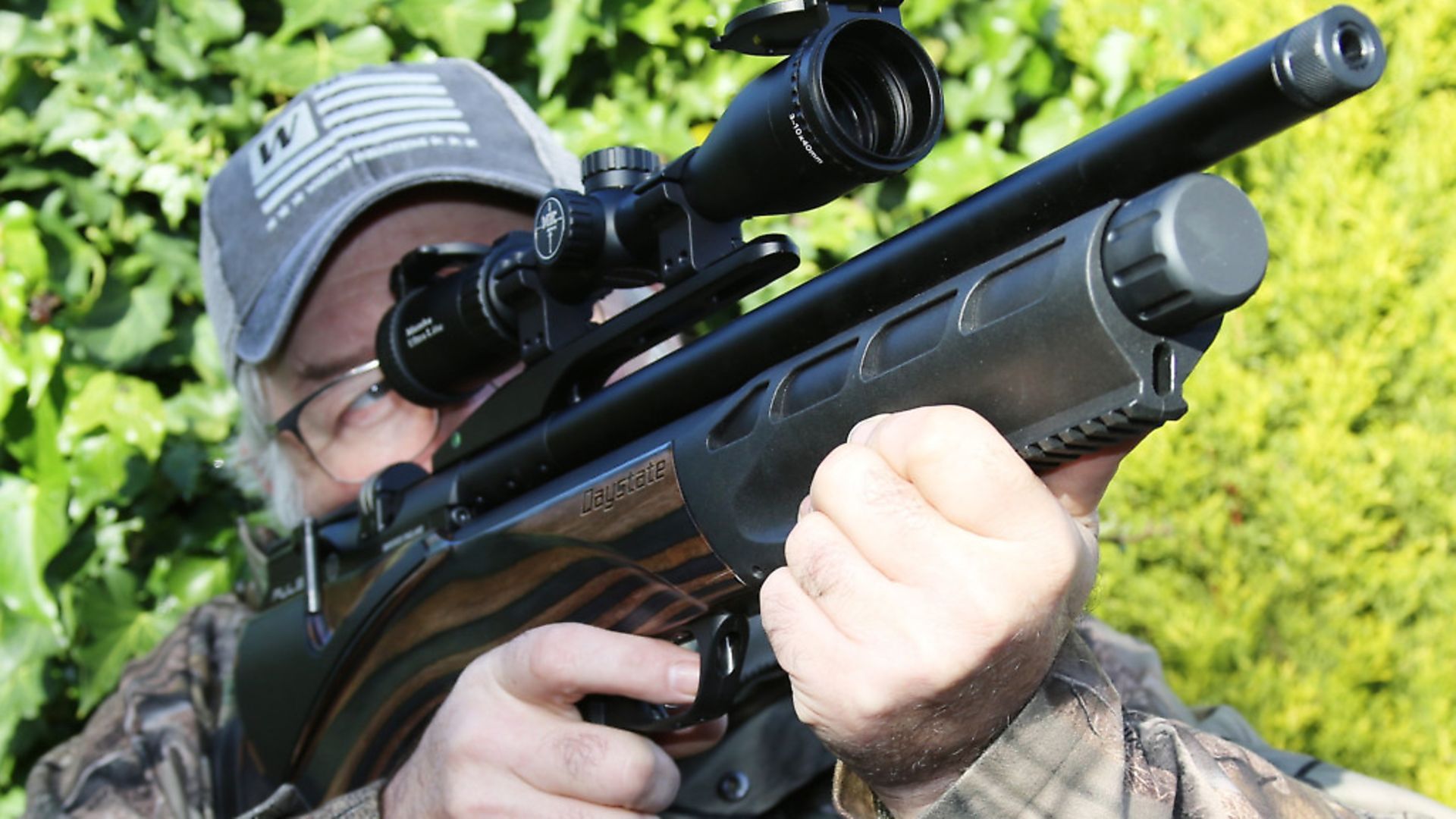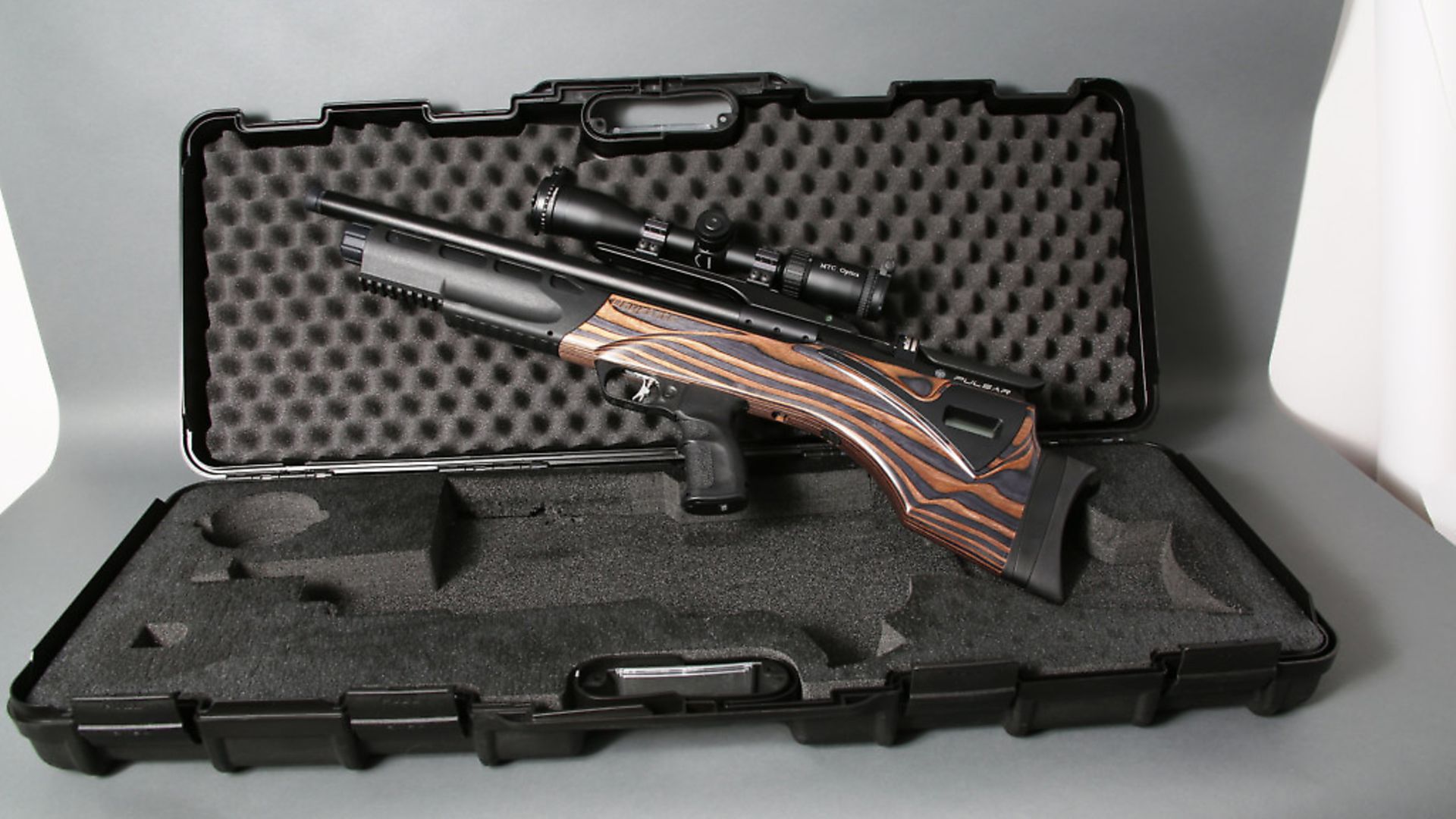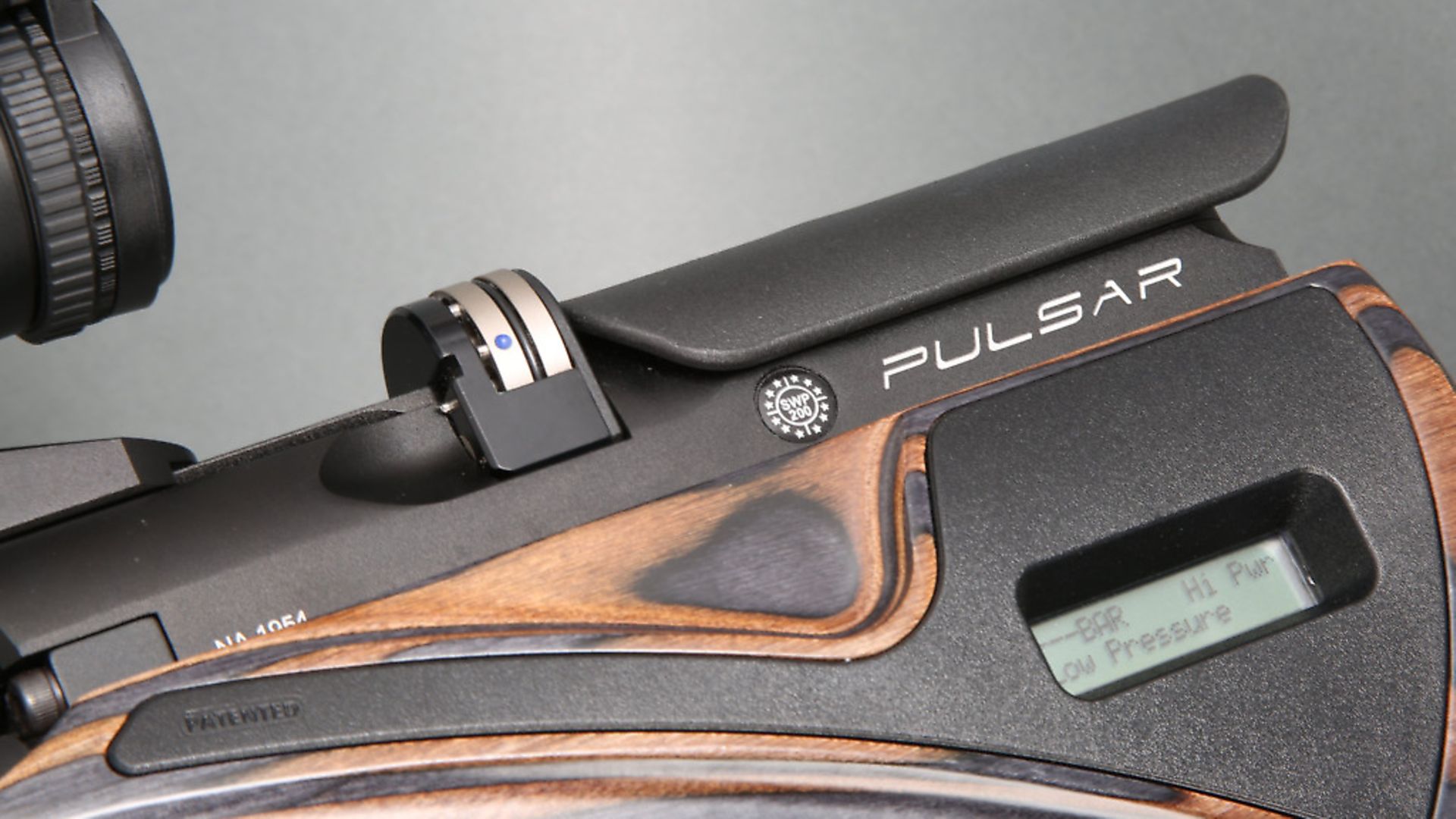The editor matches cutting edge with solid practicality
 credit: Archant
credit: Archant
Last month’s theme was pure shooting enjoyment, topped with sporting practicality. This time, I’m doing the same, only with inverse proportions of fun and performance, although the ‘practicality’ angle is even more relevant. Our test subjects this time around are the very latest version of the all-electronic, Daystate Pulsar bullpup, and the brand-new MTC Optics Mamba Ultra Lite scope. Add the Pulsar’s price tag of £1949.99 to the Mamba Ultralite’s £209.99, and you’re looking at a combination that’s a 101 pence short of 2,160 English pounds. You don’t need me to tell you what a dent that little lot would put into any airgunner’s secret stash, yet if both components aren’t entirely practical, it’s money wasted, rather than invested.
The theme
That’s the theme for this test sorted, then. I’ll cover performance, obviously, but again, even a supergun that puts pellets inside a wedding ring at 50 yards, as this can, is little more than a hi-tech ornament if it can’t handle rain, cold, sunburn and the odd bit of mishandling. Luckily, I can supply all of those, except the sun, so I asked Daystate to send me a Pulsar that had seen some action, so I could whack more air miles on it. Thus, if you spot a blemish or two on the test rifle’s chassis, that’s where they came from. Right, let’s go through a bit of Pulsar history, a rundown of features, the shooting test, and finally the initial verdict. At the same time, I’ll, cast an eye over the Mamba Ultralite scope and see what that has to offer.
Pulsar beginnings
The civilised world first saw the Daystate Pulsar at the 2015 S.H.O.T. Show, and thereafter at the British Shooting Show. I attended both launches and having seen the prototype Pulsar at various stages of its development, I was keen to see what the reaction would be when show-goers put the rifle to their shoulders. As suspected, the reaction was universally positive, with comments usually constructed around the ‘blimey, that’s stable, isn’t it?’ Even a few internet ‘experts’, always those who’d never seen a Pulsar first-hand, let alone handled or shot one, were obliged to concede that it was, indeed, rock-solid on aim.
 credit: Archant
credit: Archant
Flying start
It sold well, too, but then it needed to because its development was a staggering 20 times more expensive than that of Daystate’s first electronic rifle, the MK3. Yes, I had to check that stat, too, and it really is ’20 times’. The Pulsar’s synthetic mouldings accounted for an eye-watering chunk of that, the rest being poured into its all-embracing electronics, plus the stock design and its various options, with the scope mount, hard case, laser, trigger system and a zillion essential sundry items gobbling up the rest.
This was a no-holds-barred project and Daystate’s consultant electronics genius, David Snook, burned gallons of the midnight oil to bring the Pulsar home in time for its Stateside launch. All the new rifle needed was a name, and this was supplied by the least-talented consultant to ever draw a considered breath...me.
Then and now
Airgun development, even the kind packed into cutting-edge rifles like the Pulsar, is a moveable feast. As soon as the top companies complete a project, they start to look for ways of improving matters, and with electronics the pace of such evolution is on the scary side of impressive.
The Daystate Pulsar sitting in the gun rack as I write, has evolved in several key areas, although the most noticeable of these concerns its non-electronic features. First, there’s the new laminated ambidextrous Saxon stock, so called because it uses the laminate first applied to the company’s limited edition Saxon rifle. As an aside, Daystate intends to add new stock tints to its range at the rate of one every month or so. It’s all part of the company’s 40th anniversary celebrations, apparently.
 credit: Archant
credit: Archant
Hold on, we’re going in
The rifle’s intermount has also seen some subtle changes, but the major performance upgrades have taken place inside the rifle. Where once a single capacitor served as mission control for the Pulsar’s highly modified Harper electronic action, Daystate has now installed three. This hat-trick of microprocessing firepower provides three times the power of the single unit, from a more convenient, lower profile housing. The latest brainpower upgrade is also more resistant to water and the weather in general, which also ticks a major practicality box, of course.
Many of the changes are locked securely behind the ‘sorry, can’t tell you’ clause that seems to come as standard with the top guns these days, but I can confirm there’s been a ‘significant upgrade’ to the Pulsar’s main firing valve and the system that controls its efficiency. The result is not only more of that efficiency, in terms of shots per charge and consistent velocity output, but a hike in longevity and reliability. The latter points are practical pluses, so the Pulsar is ticking along nicely so far.
Electronic options
It’s a plain, practical fact that many, many airgunners are intimidated by electronic guns. Shooters of a certain age, who are more likely to be able to afford airguns in this price bracket, can have a ‘we fear change’ mentality, which also embraces computers, the Internet, mobile phones, and pretty much anything with an electronic menu that requires the user to ‘scroll through’, or heaven help us, ‘toggle’. Those of us who blipped, flipped and twitched our way through the 13-stage options roll call of the Daystate MK3, which included the essential privilege of having the illumination on the safety catch activated or not, will understand why the very latest incarnation has been simplified.
 credit: Archant
credit: Archant
And then there were three
The Pulsar of 2019 has ‘just’ three variables; the power adjustment – low, medium or high – which will rarely be used in sub-12 format, plus a ‘magazine on/off and reset’ mode, and finally ‘laser on/off’, which controls the rifle’s on-board laser. The Pulsar’s laser, which I happen to know was originally fitted because David Snook and Tony Belas ‘thought it would be cool’, hasn’t been left out of the upgrade programme.
The eye-safe laser Daystate use now has a two-axis housing, not the ‘triangulation’ system formerly fitted. This makes zeroing it far simpler and, yes, practical. Depending on where the user positions the ‘dot’ of the laser, it can also be used as an in-scope rangefinding system – more on which in next month’s follow-up test - and as an anti-cant device to back up the spirit level incorporated in the intermount. Basically, if the laser spot isn’t sitting on the scope’s vertical cross hair, you’re canting the rifle … provided you can see the laser, of course. I’m red-green colourblind so I struggle in the daylight, but at night, I can see this being another practical feature.
The ‘anti-puff’ upgrade
If ever a new feature needed a better name, Daystate’s ‘anti-puff’ system is the very fellow. Name notwithstanding, this is a most practical addition to the Pulsar’s electronic repertoire because it takes into full account human fallibility. Between shots, Pulsar owners are supposed to apply the rifle’s safety catch, but some don’t. Pre anti-puff, forgetting to activate the Pulsar’s sidelever, thereby not recocking and reloading the rifle, a squeeze on the trigger was met with a ‘puff’ of empty air, hence the name. Post anti-puff, the rifle’s action automatically goes into standby mode and won’t fire until it’s recocked. Simple, practical brilliance is always the best kind.
Output facts and figures
The Pulsar’s air reservoir has an accommodating volume of 300 cc, which can be charged to a maximum of 250 bar. If the rifle is configured to sub-12 ft.lbs., a 230 bar charge will yield a full 250-plus, electronically-regulated shots in .22 calibre, and around 220 in .177. FAC holders can specify their preferred power level and in .25 calibre, the Pulsar will produce 55 shots at 50 ft.lbs. from a 250 bar charge, and the same number of shots at 38 ft.lbs. from a 230 bar charge.
In .22, fully-ticketed Pulsar owners can expect 55 shots at 35ft.lbs from 230 bar, and 43 shots at 50ft.lbs. from 250 bar. As with all Daystate PCPs, the rifles are set up individually at the factory and the required charging pressure will be stated on a small decal let into the left-hand side of the action. The test rifle’s pressure is set at 200 bar, so, simple chap that I am, that’s what I used.
The electronic output from the rifle’s battery pack varies according to which batteries are used, but the most basic, six, AA batteries, option generates ‘thousands of shots’, according to the manual, with Lithium PP3 battery option good for around 14,000 cycles. No shortage of motive power, then, plus the Pulsar will warn you when its batteries are low, so there’s no excuse to run out of juice, either.
Consistent performer
Consistency tests so far show an average variation of 11 f.p.s. from the 11.7 ft.lbs. .177 I’ve tested, and 12 f.p.s. from a .22, using unsorted pellets. Pellets that have been weighed, washed, lubed and inspected might well reduce the variation by a couple of feet per second, but in the all-important world of practicality, this increase in efficiency lives mainly in the shooter’s head. To some, including me at times, this qualifies the whole pellet preparation deal as worth doing, and wherever your head’s at on this subject, you’d be a silly old nonsense not to work long and hard to discover the best possible pellet for your rifle.
Clinical accuracy
I’ve accuracy-tested this rifle to the tune of thousands of shots at every possible, practical range, and provided it’s fed the right pellets, it’s a machine … which it is, of course. The barrel shroud and its sound-absorbing voids and chambers do a sturdy job of snuffing out muzzle noise, but decibel-reduction freaks can spin on an optional moderator and turn the Pulsar into a near-silent robot of clinical accuracy.
Make no mistake, the one feature this incredible rifle doesn’t have, is anything resembling a soul. Your Pulsar will never be ‘Old Betsy’ or anything like her.
From its advisory LCD panel, through that spark-inspired, adjustable match trigger, along the capacitor-energised, configured-for-each shot-cycle, computer-controlled action and out into the real world via that competition grade barrel, the Pulsar pulses about its business with neither quirk nor foible. This rifle has an electronic heart, not a beating one. As I said, it’s a machine – but what an incredible machine it is!
The MTC Optics Mamba Ultra Lite 3-10 x 40 PA
There are three models in the new Mamba Ultra Lite range, and I’m concentrating on the 3-10 x 40 PA, which has been designed for airgun and smallbore use. From the start, as the name suggests, MTC Optics went for a lightweight scope, hence the 25mm body tube and compact size. The Ultra Lite brief also demanded top performance, which meant fitting top quality, fully multicoated lenses which return light-transmission figures that compare to scopes of similar price using 30mm diameter tubes.
MTC’s SCB2, multi-aimpoint reticle is fitted, complete with one-touch illumination, plus a sidewheel focusing system with a range of 10 metres to infinity on full magnification. The eye-relief comes in at around 100mm and this latest Mamba is kitted out with flip-up, magnetic lens covers as standard, with the rear cover incorporating a 2x magnifier, should you need optical assistance to read the focus settings.
The result is an extremely handy, versatile, high-performance scope that weighs in it just 538 grammes, or 1lb 3oz in old money. Image quality is commendable and apart from forgetting to turn off the illuminated reticle and draining the battery, there’s nothing to worry about it with this scope. It’s a genuine fit and forget item. I’ll see how the Mamba Ultra Lite handles a bit of English winter over the coming weeks, and include the report in next month’s follow-up test. So far, so good, though.
Specification
Model: Pulsar
Manufacturer: Daystate
Country of origin: UK
Price: £1949.99 including hard case
Type: Pre-charged, multi-shot, bullpup sporter with fully electronic action
Calibre: .22,.177, .25, .30
Cocking/loading: Sidelever and supplied single-shot tray
Loading: Via removable, rotary 10-shot magazine
Trigger: 2-stage, adjustable, battery-powered, electronic, with manual, resettable safety
Stock type: Ambidextrous laminate – sidelever can be switched to either side – stock weight: 3.4kg (7.5lbs)
Length: 760mm (30ins)
Barrel: 430mm (17ins)
Fill pressure: Max 250 bar (designed pressure stated on each rifle)
Shots per charge: 250 in .22, 220 in .177 at sub-12 ft.lbs. configuration. Hi-power versions available.
Average energy: 11.7 ft.lbs.
Contact: Daystate on daystate.com
Tel: 01785 859122
RRP: £1949.99
__________________________________________________
Read more gun tests from Terry Doe...
BSA R-10 SE Super Carbine
Kral Arms Puncher Jumbo
Air Arms TDR S510